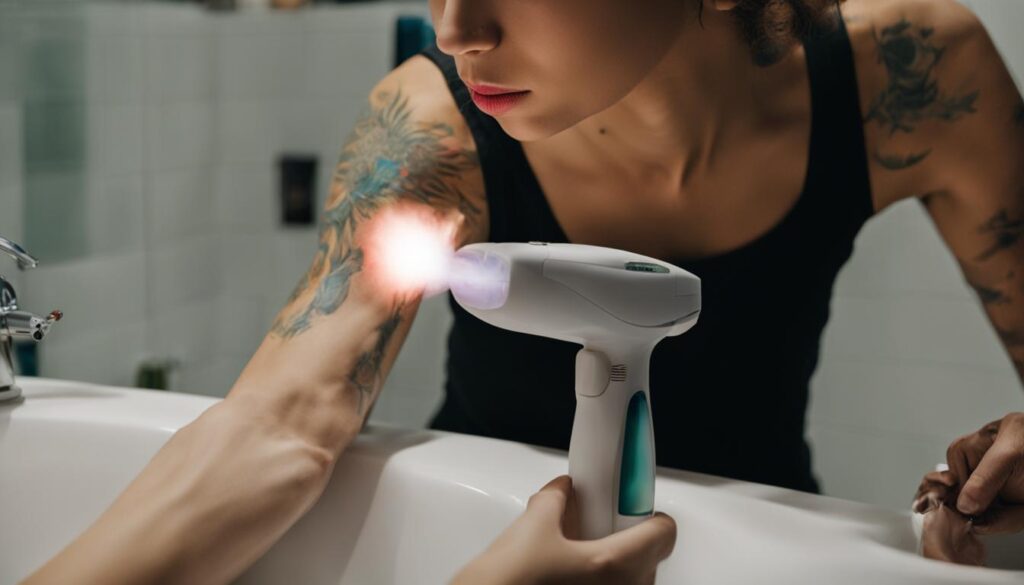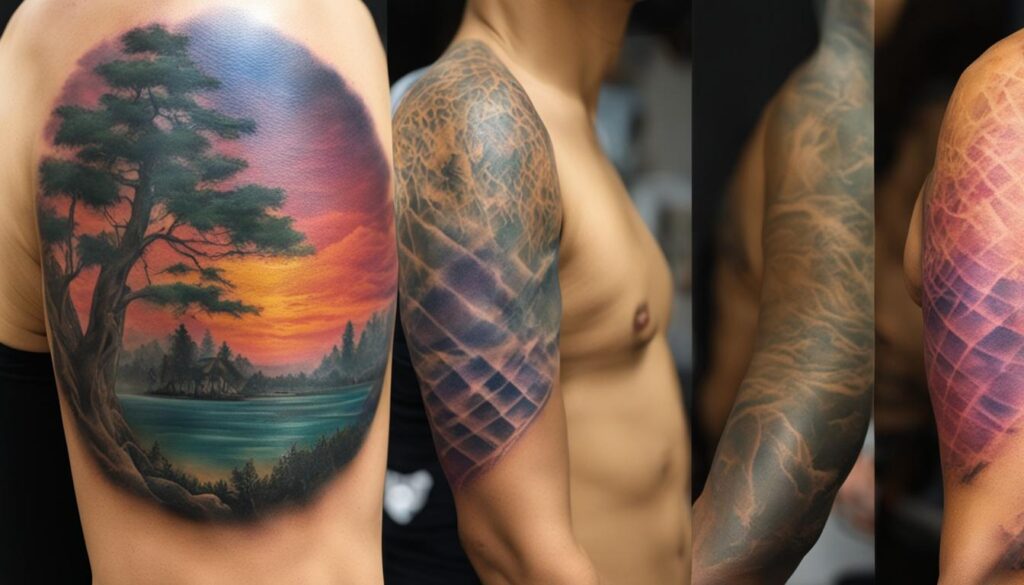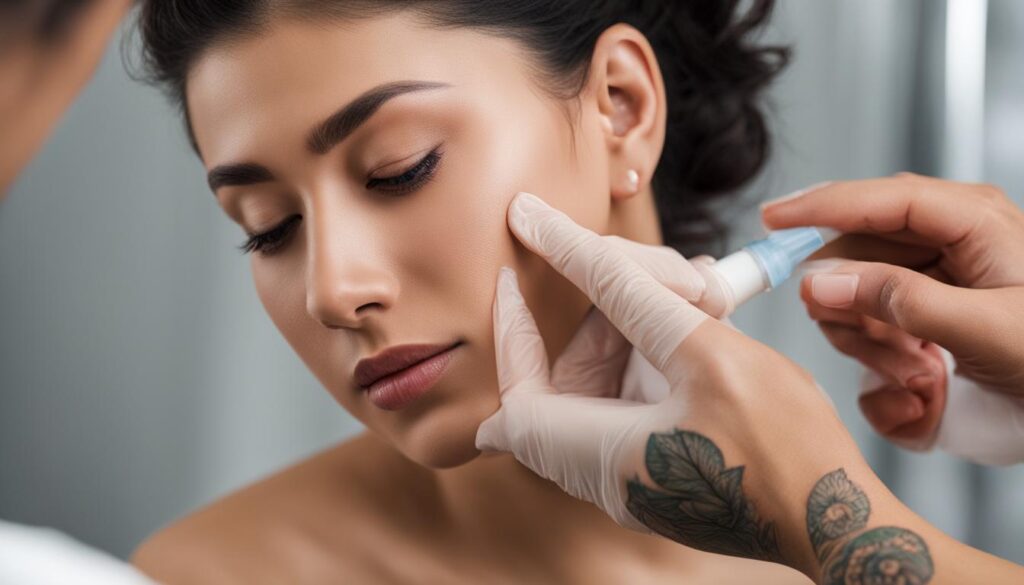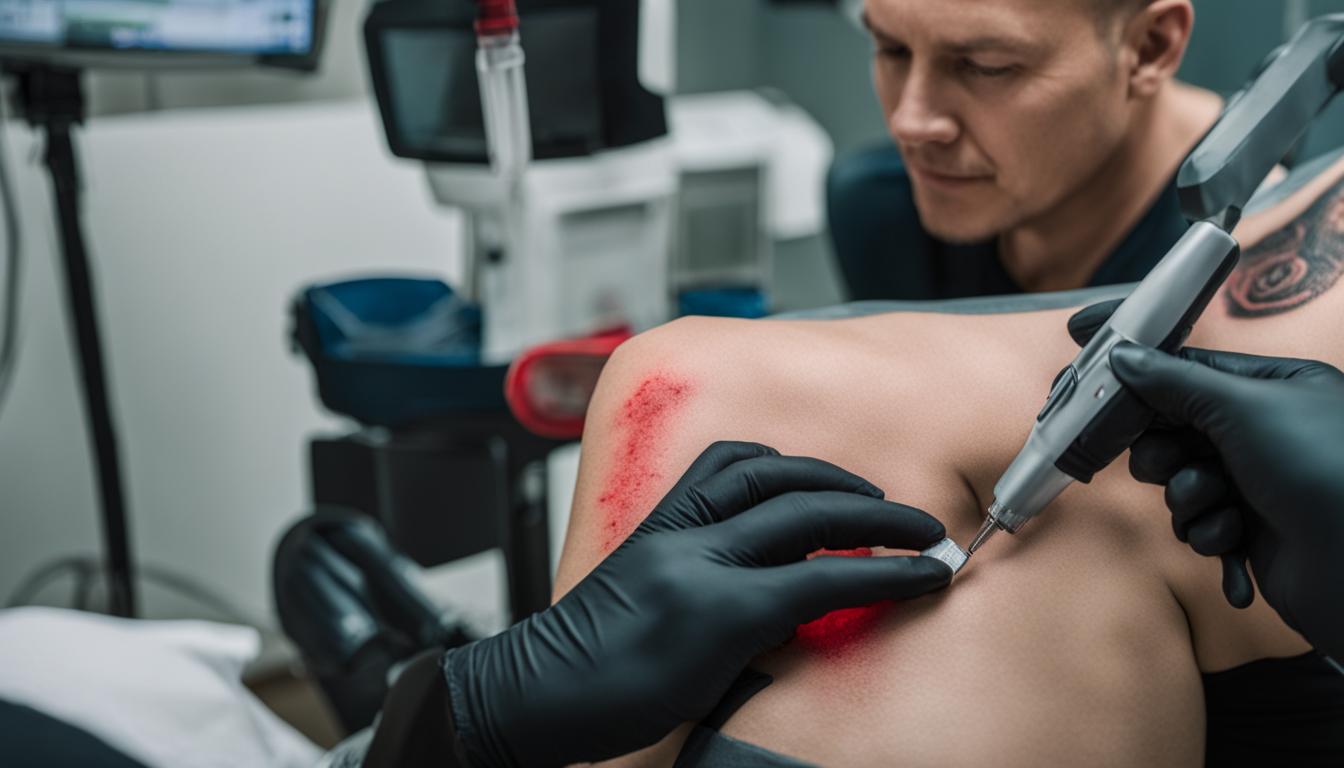Laser tattoo removal is a popular method for removing unwanted tattoos. It involves using lasers to break down the ink particles in the skin, allowing them to be eliminated by the body’s immune system. There are different types of tattoo removal procedures, including laser tattoo removal, dermabrasion, chemical peels, surgical excision, and tattoo removal creams. Each method has its own advantages and considerations. Laser tattoo removal is the most common and effective method, but it may require multiple sessions to completely remove a tattoo.
Key Takeaways:
- Laser tattoo removal is a popular method for removing unwanted tattoos.
- It involves using lasers to break down the ink particles in the skin.
- There are different types of tattoo removal procedures, but laser tattoo removal is the most common and effective method.
- Laser tattoo removal may require multiple sessions to completely remove a tattoo.
- Consult a healthcare provider or dermatologist to determine the best removal options for you.
Types of Tattoo Removal
When it comes to removing unwanted tattoos, there are various methods available. Each method has its own advantages and considerations, and the choice depends on factors such as the size, color, and depth of the tattoo. Let’s take a closer look at some of the most common types of tattoo removal procedures:
Laser Tattoo Removal
Laser tattoo removal is the most popular and widely used method. It involves using laser beams to break down the tattoo ink particles in the skin. The laser targets the ink without damaging the surrounding skin, allowing for gradual fading and removal of the tattoo over multiple sessions. Laser tattoo removal is effective for various tattoo colors and can be customized to suit different skin types.
Dermabrasion
Dermabrasion is a technique that involves removing the outer layers of the skin containing the tattoo ink. This is done using a rotating brush or abrasive device. The procedure can be uncomfortable and may require a local anesthetic. Dermabrasion is suitable for smaller tattoos and is not recommended for people with darker skin tones.
Chemical Peels
Chemical peels use chemicals to peel off the top layers of the skin, including the layers containing the tattoo ink. The chemicals create a controlled injury, leading to the shedding of the damaged skin. Chemical peels are best suited for tattoos that are close to the surface of the skin and have lighter ink colors.
Surgical Excision
Surgical excision involves cutting out the tattooed skin and stitching the surrounding skin together. This method is typically used for small tattoos and may leave a scar. Surgical excision is often recommended for tattoos that are difficult to remove using other methods, such as those with deep or thick ink layers.
Tattoo Removal Creams
Tattoo removal creams are topical products that claim to fade and remove tattoos. These creams typically contain ingredients that help break down the tattoo ink. However, their effectiveness is often limited, and results may vary. Tattoo removal creams are generally more suitable for lighter and smaller tattoos.
It’s important to consult with a healthcare provider or dermatologist to determine the best tattoo removal method for your specific tattoo. Each method has its own pros and cons, and a professional can help you make an informed decision based on your individual needs and goals.
The Laser Tattoo Removal Process
The laser tattoo removal process is a multi-step procedure that involves breaking down tattoo ink particles in the skin using laser technology. This process requires multiple sessions and involves various steps to ensure the best possible results.
First, a trained physician will evaluate the tattoo to determine the most effective approach for removal. Factors such as the size, color, and depth of the tattoo will be taken into consideration. Protective eye shields are worn during the treatment to protect the eyes from the laser light.
Next, the laser energy is tested on the skin to determine the appropriate energy level for treatment. The laser light is then directed to the tattooed skin using a handpiece. The laser works by targeting the pigmented ink particles in the skin, breaking them down into smaller fragments.
“The laser tattoo removal process involves breaking down tattoo ink particles in the skin using laser technology.”
The number of sessions required for complete removal depends on various factors, such as the size of the tattoo and the type of ink used. After each session, the healthcare provider will provide instructions for post-treatment care to promote proper healing.
| Factors Affecting Laser Tattoo Removal Process | Considerations |
|---|---|
| Tattoo Size | The larger the tattoo, the more sessions may be required for complete removal. |
| Tattoo Color | Some colors, such as black and blue, respond better to laser treatment, while others, such as green, yellow, and red, may be more challenging to remove. |
| Tattoo Depth | Tattoos that are deeper in the skin may require additional sessions for complete removal. |
The laser tattoo removal process is a gradual and effective method for eliminating unwanted tattoos. By following the recommended treatment plan and taking proper care after each session, individuals can achieve significant fading or complete removal of their tattoos.
Why Multiple Sessions Are Required for Laser Tattoo Removal
When it comes to laser tattoo removal, multiple sessions are often required to achieve the desired results. This is because tattoos are applied in layers and the ink pigment needs time to be flushed out by the body’s immune system. The laser breaks down the ink particles into smaller fragments, which are then eliminated by the body. However, the skin needs time to heal between sessions, and the process can cause temporary side effects such as swelling, blistering, and color changes.
Additionally, certain colors of tattoo dye may be more difficult to remove than others. While black and blue tattoos tend to respond well to laser treatment, colors like green, yellow, and red can be more challenging to remove. The depth of the pigment can also affect the number of sessions required. Some pigment may be too deep for the laser to reach, necessitating additional treatments.
It’s important to note that each individual’s response to laser tattoo removal can vary. While some tattoos may be completely removed, others may only fade or become lighter. The success of the treatment depends on various factors, including the color and quality of the ink, the depth of the tattoo, and the individual’s skin tone.
| Factors Affecting Tattoo Removal | Impact on Treatment |
|---|---|
| Tattoo color | Some colors are more challenging to remove than others |
| Tattoo depth | Deeper pigments may require more sessions |
| Individual skin tone | Can affect the response to laser treatment |
In conclusion, laser tattoo removal is a process that requires patience and multiple sessions to achieve optimal results. It’s important to consult with a healthcare provider or dermatologist who specializes in tattoo removal to discuss your specific tattoo and develop a personalized treatment plan. By understanding the factors that affect the removal process and managing expectations, individuals can make informed decisions about their tattoo removal journey.
Expectations for Tattoo Removal Results
When undergoing laser tattoo removal, it is important to have realistic expectations regarding the results. While laser treatment can effectively fade or remove tattoos, the outcome may vary from person to person depending on several factors.
One of the key factors influencing the success of tattoo removal is the color and quality of the ink used. Dark-colored tattoos, such as black or blue, tend to respond better to laser treatment compared to lighter shades like green, yellow, or red. Additionally, tattoos with high-quality ink are generally easier to remove than those with low-quality or homemade ink.
The size and depth of the tattoo also play a role in the removal process. Smaller tattoos may require fewer treatment sessions to achieve satisfactory results, while larger and more intricate designs may take longer. Deeply embedded ink may also require additional sessions to fully eliminate.
Individual characteristics, such as skin tone and body’s immune response, can also affect the outcome of tattoo removal. People with lighter skin tones often experience better results, as the laser targets the ink without causing significant damage to the surrounding skin. However, advancements in laser technology have made it possible to achieve successful removal for individuals with darker skin tones as well.
Risks and Consultation
Before undergoing laser tattoo removal, it is crucial to consult with a healthcare provider or dermatologist experienced in tattoo removal procedures. They will assess your tattoo, evaluate your skin type, and discuss your expectations. It’s important to remember that complete tattoo removal may not always be possible, and some fading or remnants of the tattoo may remain.
“The success of laser tattoo removal greatly depends on various factors such as the type of tattoo ink, the depth of the tattoo, and the individual’s skin characteristics.”
During the consultation, the healthcare provider will explain the risks and potential side effects of the procedure, which may include temporary redness, swelling, blistering, or changes in skin pigmentation. They will also provide detailed instructions for post-treatment care and follow-up sessions, if necessary. By setting realistic expectations and following medical advice, you can maximize the chances of achieving satisfactory tattoo removal results.
At-Home Tattoo Removal Methods
While there are at-home tattoo removal methods available, it’s important to note that they are not recommended by healthcare professionals. These methods include tattoo removal creams and salabrasion. Tattoo removal creams claim to break down ink particles, but they often take a long time to show results and may cause skin irritation. Salabrasion, on the other hand, involves rubbing the skin with salt, which can be painful and increases the risk of infection.
It’s crucial to understand that professional tattoo removal services performed by a healthcare provider or dermatologist are the safest and most effective option. These professionals have the knowledge, experience, and tools necessary to safely and efficiently remove tattoos. They can assess your specific tattoo and determine the best removal procedure for you.
It’s understandable that some individuals may be tempted to try at-home methods due to cost or convenience, but it’s important to prioritize your safety and the quality of the results. Seeking professional tattoo removal services ensures that you receive proper care and guidance throughout the process, leading to the best possible outcomes.
Table: Comparison of At-Home Tattoo Removal Methods with Professional Tattoo Removal
| Method | At-Home Tattoo Removal | Professional Tattoo Removal |
|---|---|---|
| Effectiveness | Variable results | Higher success rate |
| Safety | Potential for skin irritation and infection | Performed by trained healthcare professionals |
| Speed of Results | Slow | Faster and more efficient |
| Cost | Lower upfront cost, but may require more treatments | Higher upfront cost, but fewer treatments |
Considering the potential risks and limited effectiveness, it’s highly recommended to consult with a healthcare provider or dermatologist for professional tattoo removal. They can provide a thorough evaluation of your tattoo and guide you through the best course of action based on your unique situation.

Choosing a Doctor for Tattoo Removal
When it comes to tattoo removal, it’s crucial to choose a qualified and experienced healthcare provider or dermatologist. The expertise of the doctor performing the procedure can greatly impact the success and safety of the tattoo removal process. To ensure you receive the best care, consider the following factors when choosing a doctor for tattoo removal:
- Training and Credentials: Look for a doctor who is specifically trained in tattoo removal procedures. They should have certifications and qualifications that demonstrate their expertise in this area.
- Experience: Inquire about the doctor’s experience with tattoo removal. Ask about the number of removal procedures they have performed and their success rates.
- Technology and Equipment: Find out what type of laser technology the doctor uses for tattoo removal. The latest advancements in laser technology can provide more efficient and effective results.
- Consultation: Schedule a consultation with your chosen doctor before proceeding with the tattoo removal process. This will allow you to discuss your expectations, ask any questions, and evaluate the doctor’s approach and communication style.
By selecting a reputable and skilled doctor, you can feel confident that you are in capable hands throughout your tattoo removal journey. Remember, the consultation phase is an opportunity to gather information and make an informed decision about the best course of action for your specific tattoo.
Table: Key Considerations for Choosing a Doctor
| Consideration | Details |
|---|---|
| Training and Credentials | Look for certifications and qualifications in tattoo removal procedures. |
| Experience | Inquire about the doctor’s experience and success rates in tattoo removal. |
| Technology and Equipment | Ensure the doctor utilizes the latest laser technology for optimal results. |
| Consultation | Schedule a consultation to discuss your expectations and evaluate the doctor’s approach. |
Choosing a doctor for tattoo removal is a crucial step in achieving the desired outcomes. Take the time to research and consult with professionals who have the necessary skills and experience in tattoo removal procedures. By doing so, you can feel confident in your decision and increase the likelihood of a successful tattoo removal process.

The number of sessions required for laser tattoo removal depends on the individual and the specific tattoo being treated. Factors such as the size, color, and quality of the ink can affect the efficiency of the removal process. It’s crucial to work with a qualified healthcare provider or dermatologist who can assess your tattoo and determine the appropriate number of sessions needed for optimal results.
During each laser tattoo removal session, the laser energy is used to break down the tattoo ink particles in the skin. After each session, the body needs time to heal and flush out the fragmented ink. This healing time between sessions is crucial for the overall success of the removal process. It’s important to follow the post-treatment care instructions provided by your healthcare provider to ensure proper healing and minimize the risk of complications.
Benefits of Multiple Sessions:
- Allows the immune system to eliminate the fragmented ink particles
- Reduces the risk of complications and side effects
- Improves the overall effectiveness of the tattoo removal process
- Provides time for the skin to heal between sessions
Aftercare for Tattoo Removal
Proper aftercare is crucial for ensuring optimal healing and results after a tattoo removal procedure. Following the post-treatment care instructions provided by your healthcare provider is essential to minimize the risk of complications and promote the skin’s recovery. Here are some important aftercare practices to keep in mind:
Avoiding Direct Sun Exposure:
Protecting the treated area from direct sunlight is vital during the healing process. Exposure to the sun’s UV rays can cause skin damage and hinder the healing of the treated skin. It is recommended to avoid sunbathing, tanning beds, and prolonged exposure to sunlight. If sun exposure is unavoidable, apply a broad-spectrum sunscreen with a high SPF to the treated area once it has fully healed.
Keeping the Skin Clean and Dry:
Keeping the treated area clean and dry is essential for preventing infection and promoting healing. Gently clean the area with mild, unscented soap and lukewarm water. Avoid using harsh cleansers or scrubbing the area vigorously. Pat the skin dry with a clean towel or let it air dry. Avoid swimming in pools, hot tubs, or other bodies of water until the area has fully healed.
Applying Ice Packs:
Applying ice packs or cold compresses to the treated area can help reduce swelling and discomfort. Wrap the ice pack in a clean cloth and apply it to the skin for about 10-15 minutes at a time. Take breaks in between to allow the skin to rest and avoid prolonged exposure to cold temperatures.
Using Antibiotic Ointments:
Your healthcare provider may recommend applying antibiotic ointments to the treated area to prevent infection. Follow their instructions on how often to apply the ointment and for how long. Be sure to use a clean cotton swab or your fingertips to apply the ointment and avoid touching the area with your bare hands to minimize the risk of contamination.
Remember to follow all post-treatment care instructions provided by your healthcare provider for the best possible outcome. If you have any concerns or notice any unusual symptoms during the healing process, don’t hesitate to reach out to your healthcare provider for guidance and support.

Conclusion
In conclusion, laser tattoo removal is a popular and effective method for removing unwanted tattoos. It involves multiple sessions and requires proper aftercare to ensure the best results. While complete tattoo removal may not always be possible, the majority of tattoos can be significantly faded or removed.
Consulting with a healthcare provider or dermatologist is essential to discuss your specific tattoo and determine the best removal options for you. They will evaluate factors such as the size, color, and location of the tattoo to create a personalized treatment plan.
Remember to follow the post-treatment care instructions given by your healthcare provider. This may include applying ice packs, keeping the skin clean and dry, and using recommended ointments. Avoiding direct sun exposure and using sunscreen after healing is crucial. By following these guidelines, you can optimize the healing process and achieve the best possible results from your laser tattoo removal journey.
FAQ
What is laser tattoo removal?
Laser tattoo removal is a method used to remove unwanted tattoos by breaking down the ink particles in the skin using lasers.
What are the different types of tattoo removal methods?
The different types of tattoo removal methods include laser tattoo removal, dermabrasion, chemical peels, surgical excision, and tattoo removal creams.
How does the laser tattoo removal process work?
During the laser tattoo removal process, laser beams are used to break down the tattoo ink particles in the skin, allowing them to be eliminated by the body’s immune system.
Why do multiple sessions of laser tattoo removal often required?
Multiple sessions of laser tattoo removal are often required because tattoos are applied in layers and the ink pigment needs time to be flushed out by the body’s immune system.
What results can be expected from laser tattoo removal?
The results of laser tattoo removal can vary from person to person, but most tattoos can be significantly faded or removed with the treatment.
Are at-home tattoo removal methods recommended?
No, at-home tattoo removal methods such as tattoo removal creams and salabrasion are not recommended by healthcare providers due to potential skin irritation and other risks.
How do I choose a doctor for tattoo removal?
It is important to consult with a healthcare provider or dermatologist who specializes in tattoo removal to ensure you receive appropriate and safe treatment.
How long does the tattoo removal process usually take?
The duration of the tattoo removal process can vary, but on average it can take between six and 12 sessions, or sometimes more, spaced several weeks apart.
What is the recommended aftercare for tattoo removal?
Aftercare for tattoo removal typically includes applying ice packs, keeping the skin clean and dry, using antibiotic ointments, avoiding direct sun exposure, and using sunscreen on the treated area.
What should I know about laser tattoo removal?
Laser tattoo removal is a popular and effective method for removing unwanted tattoos, but it requires multiple sessions and proper aftercare for optimal results.


